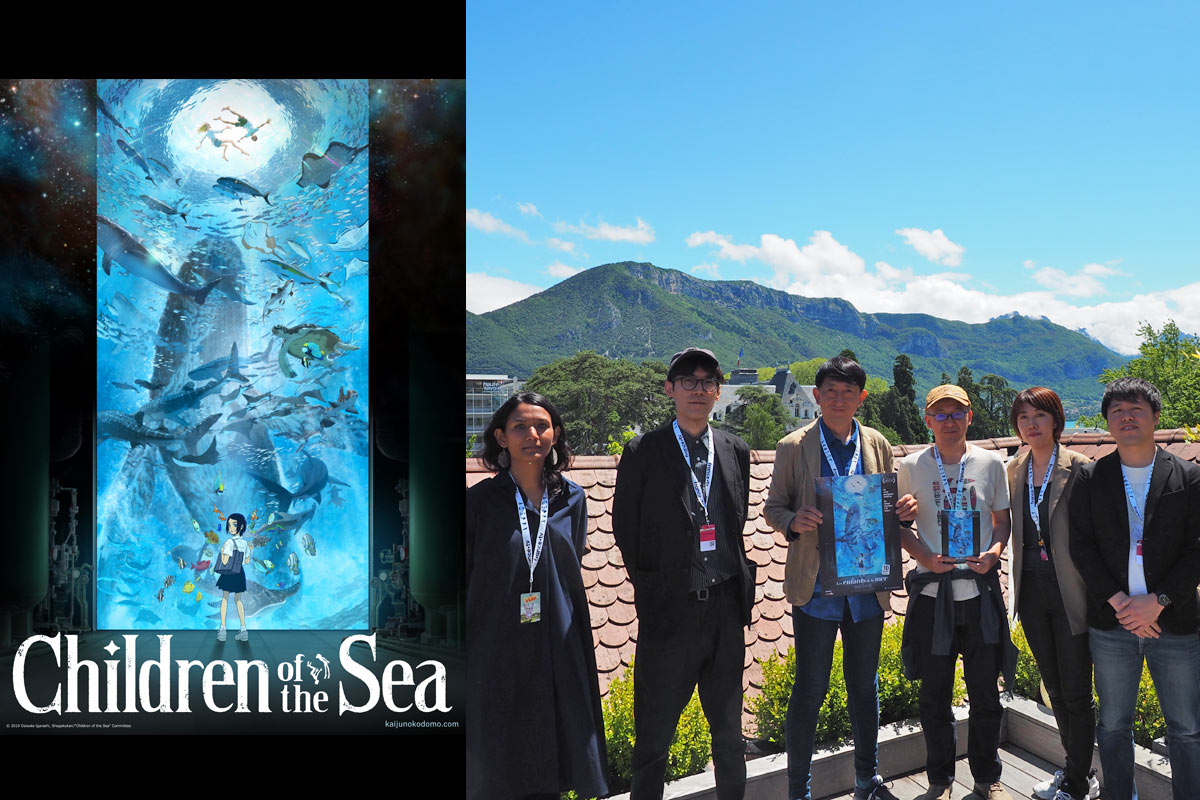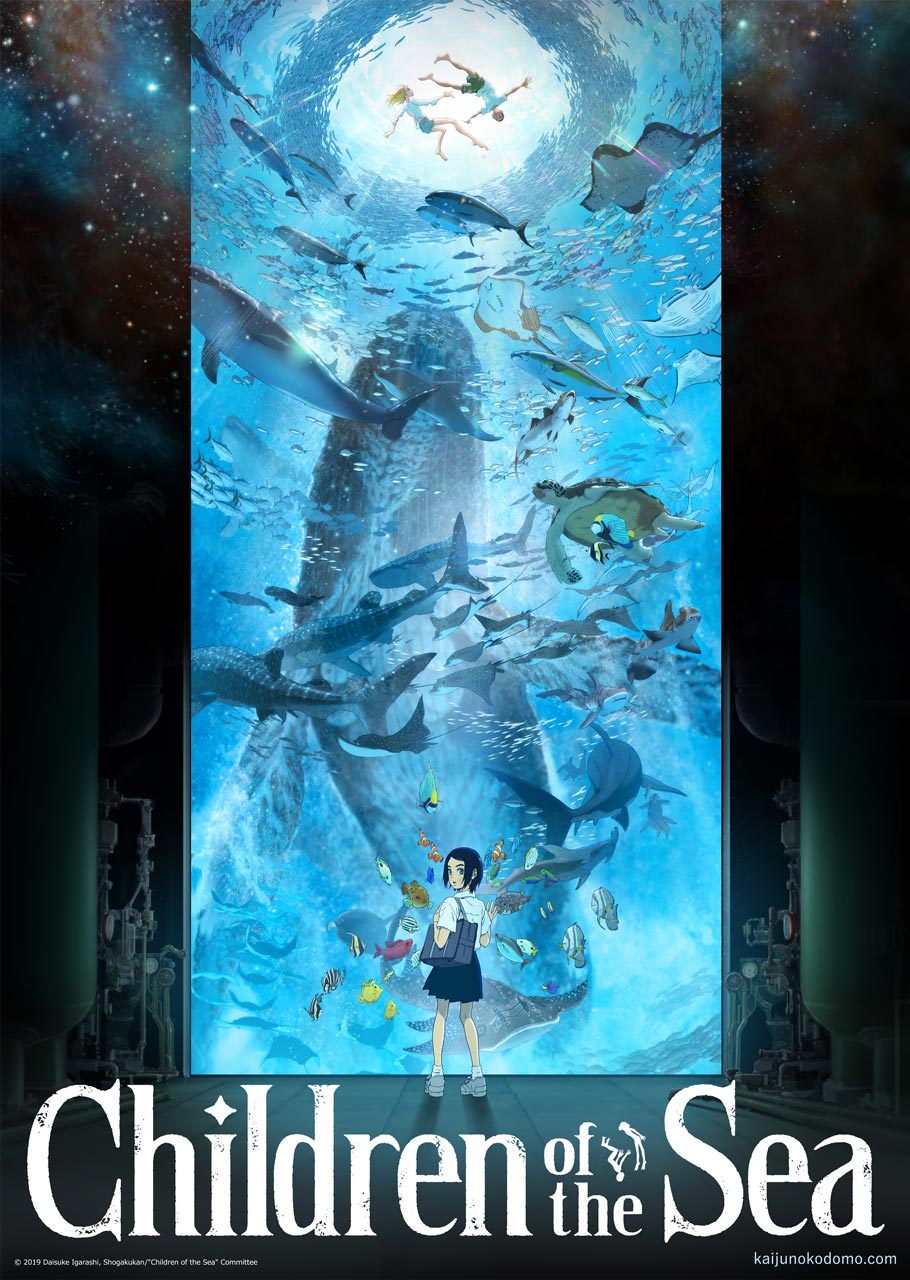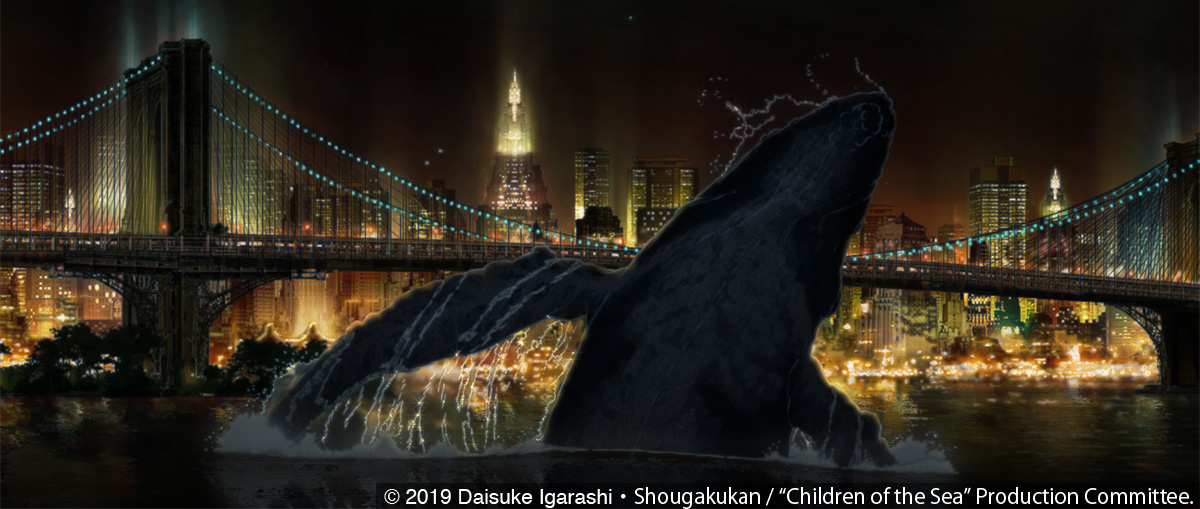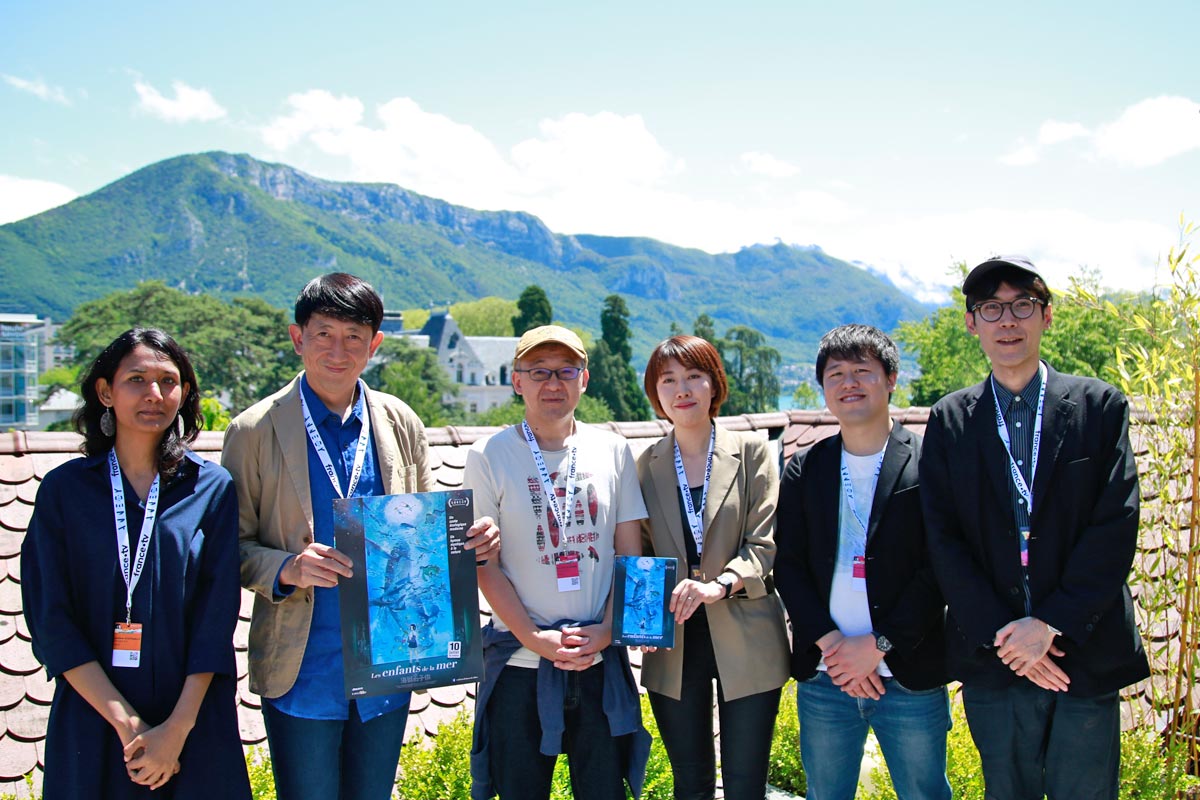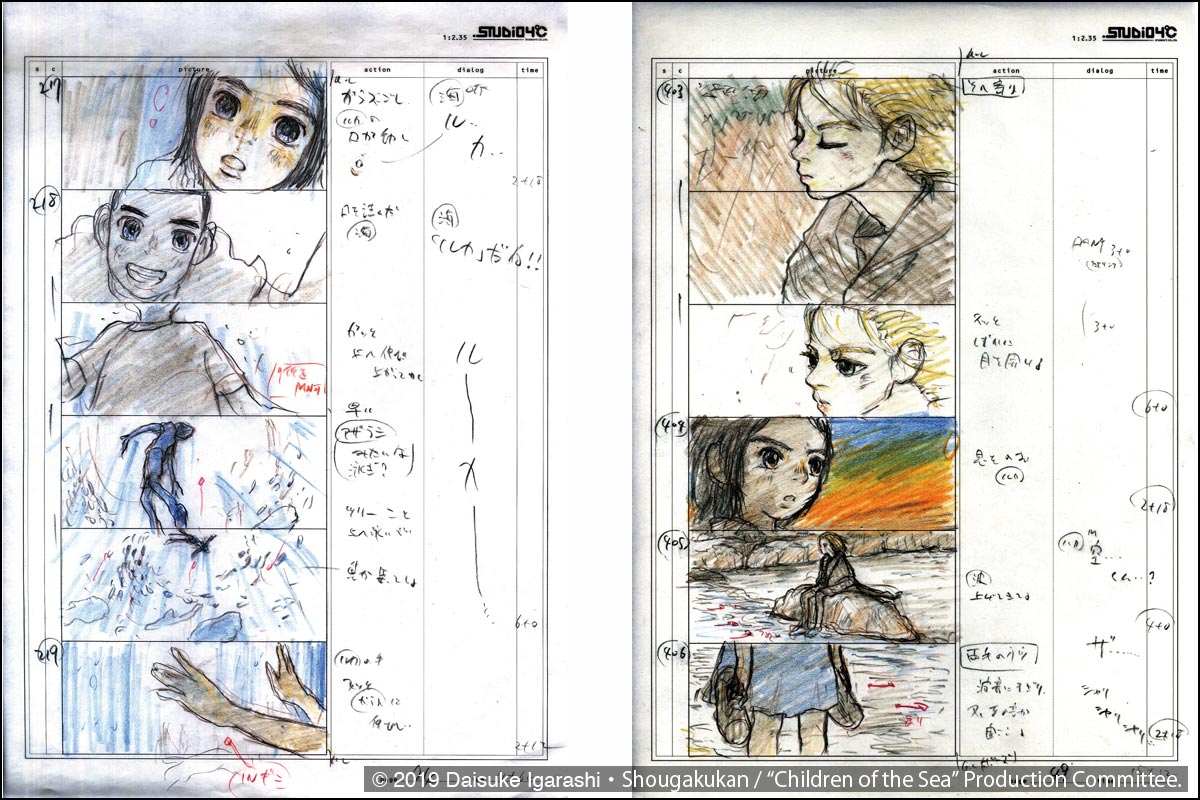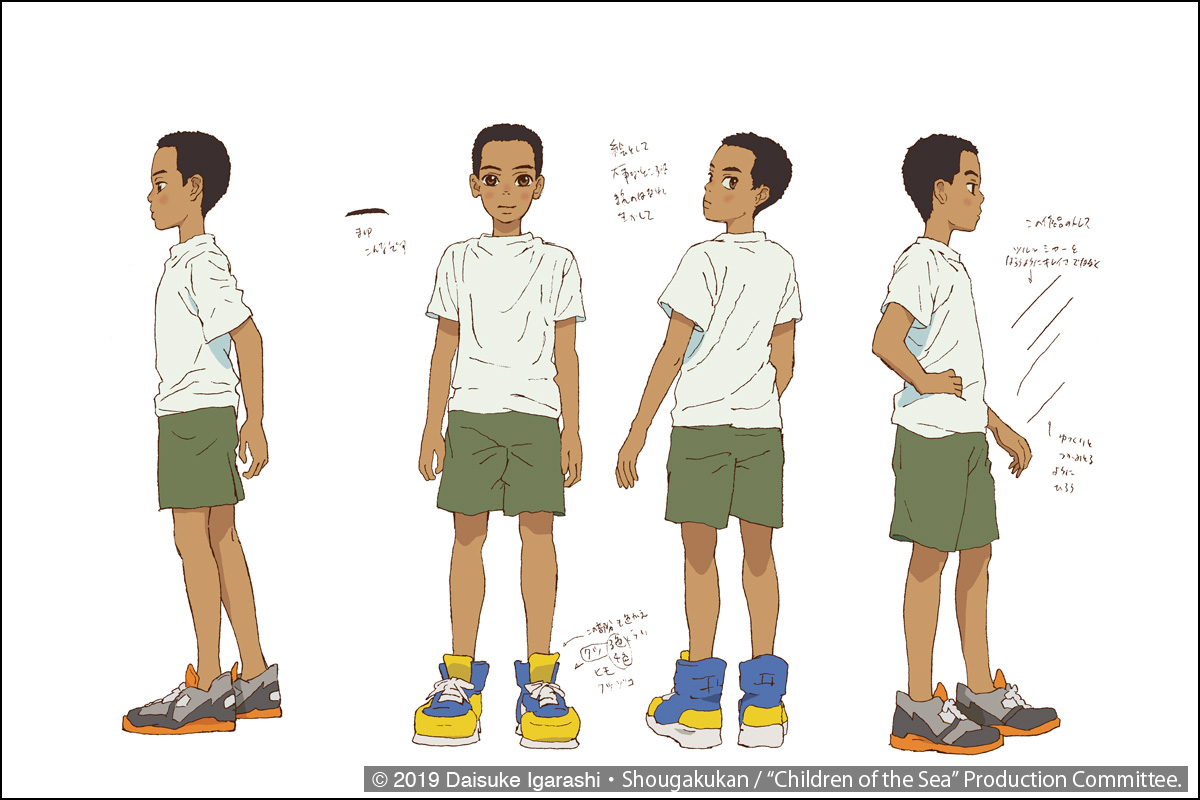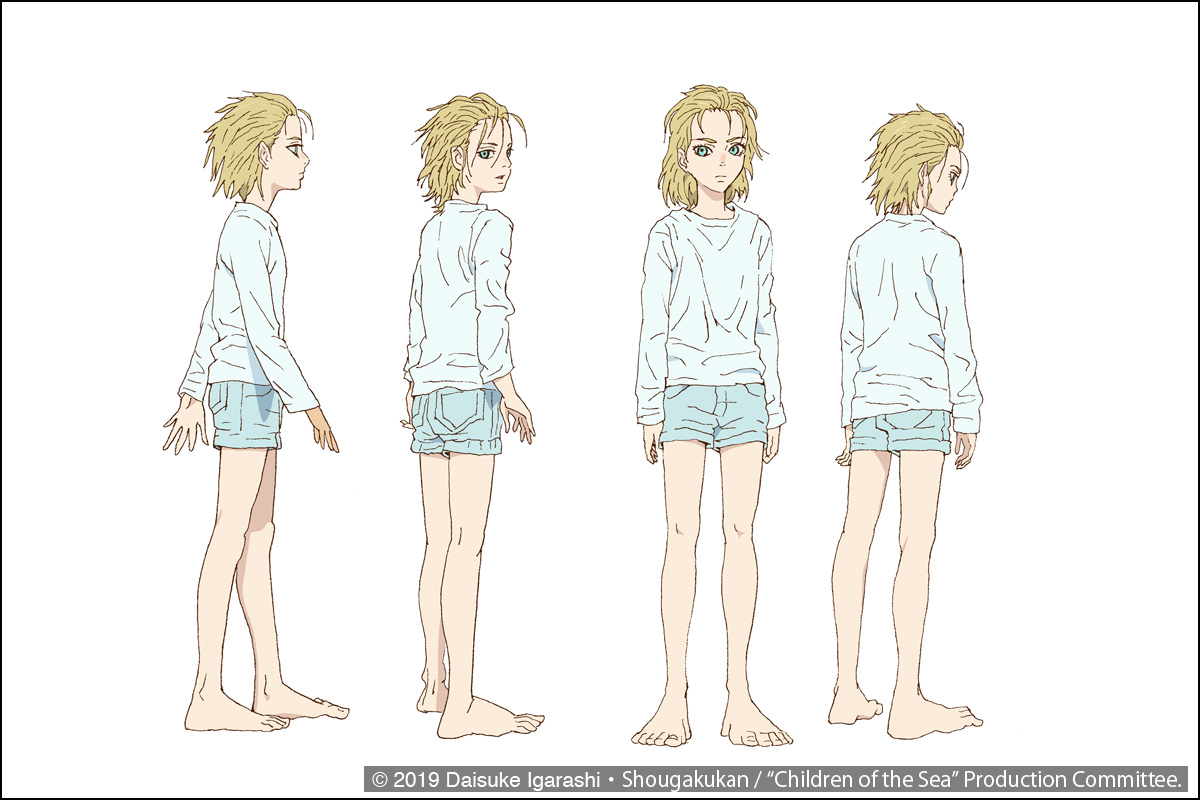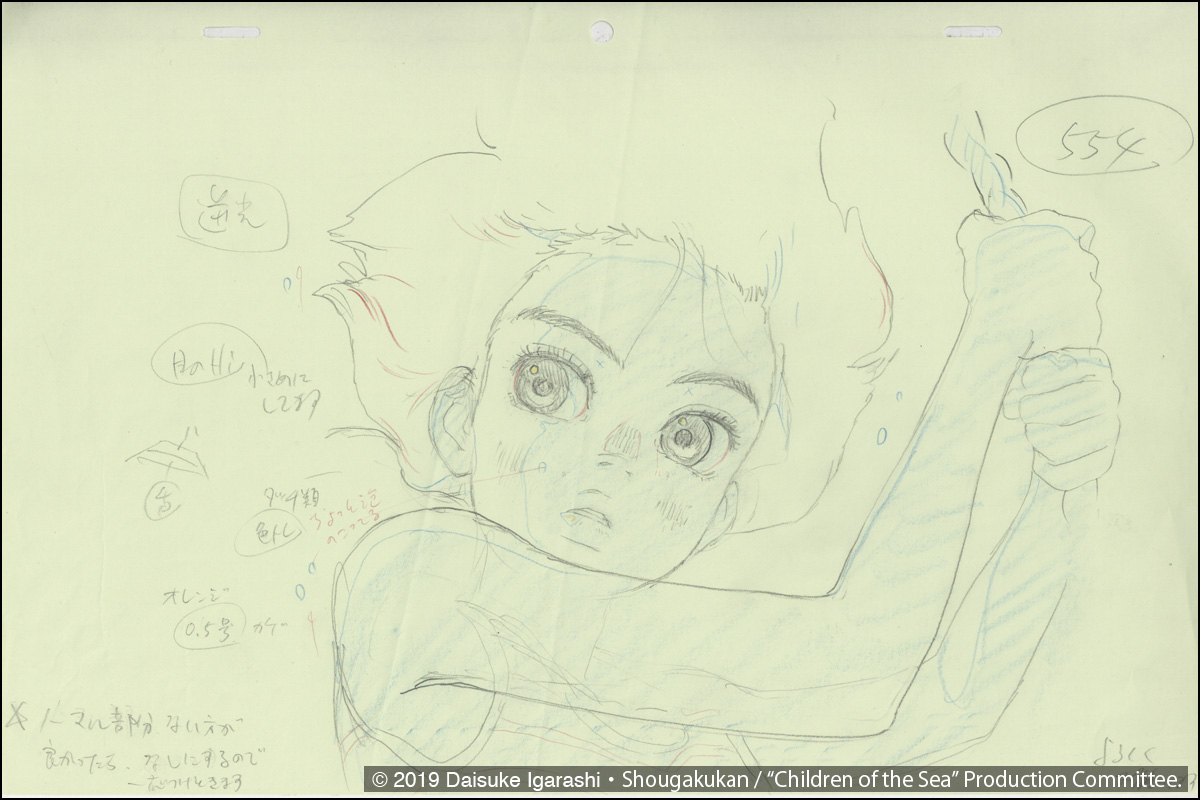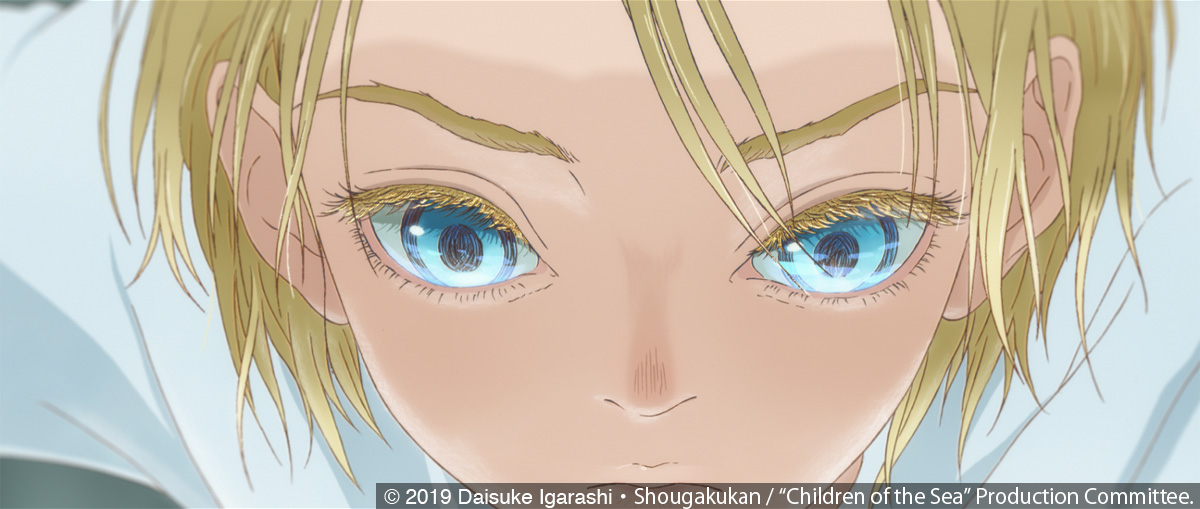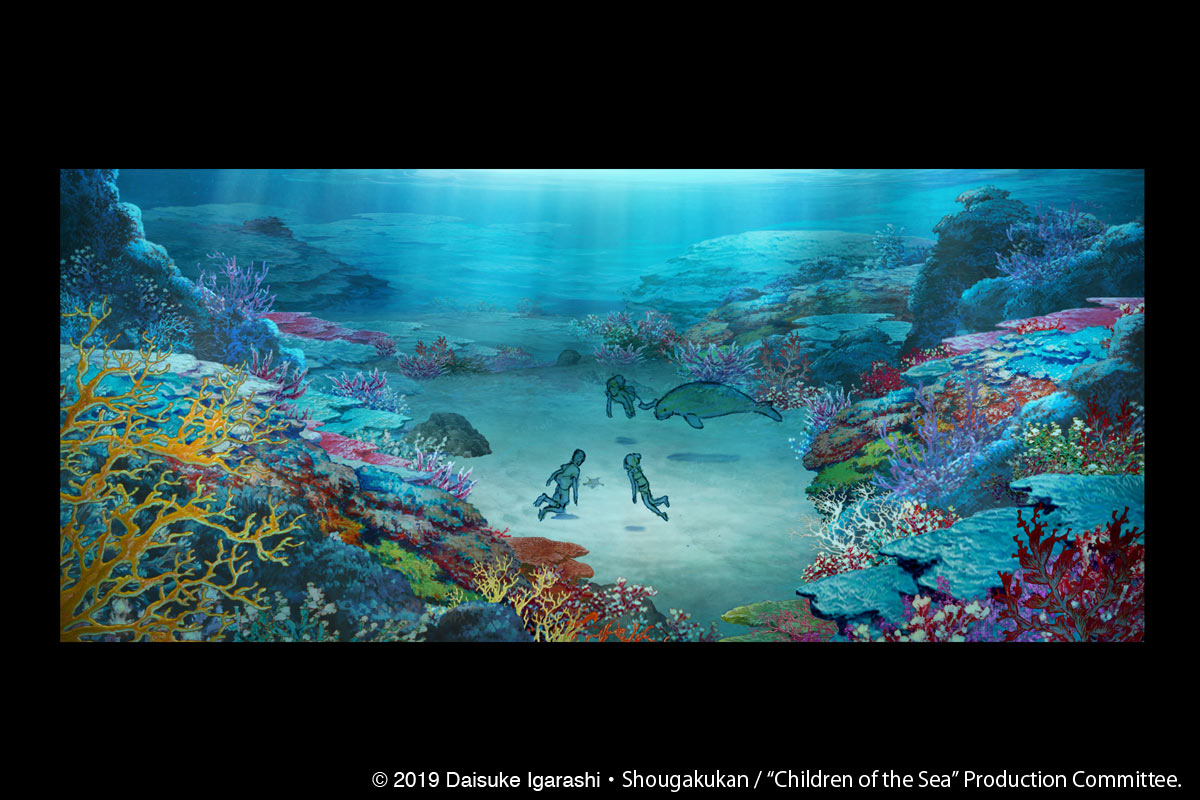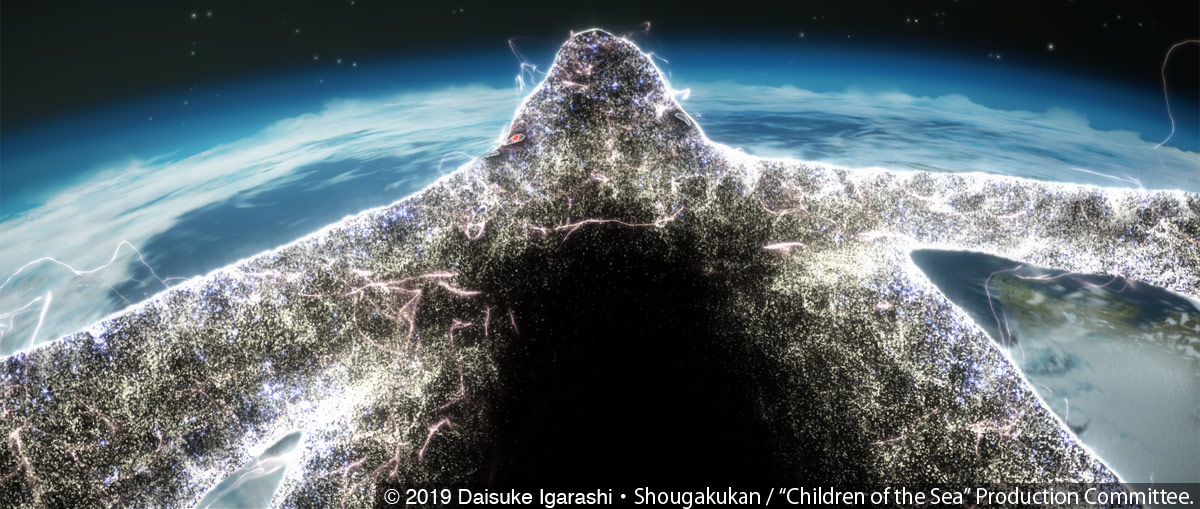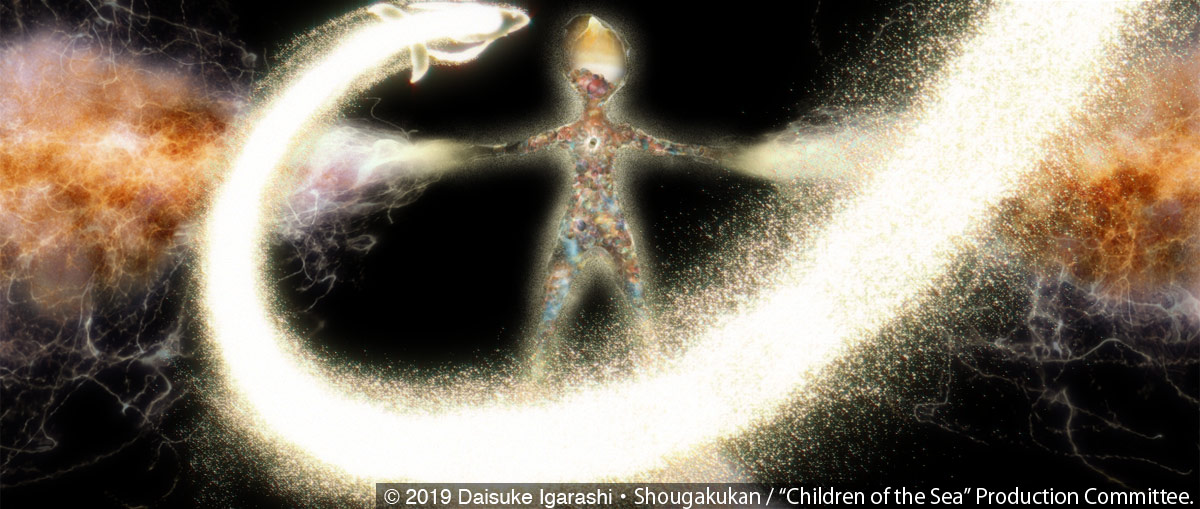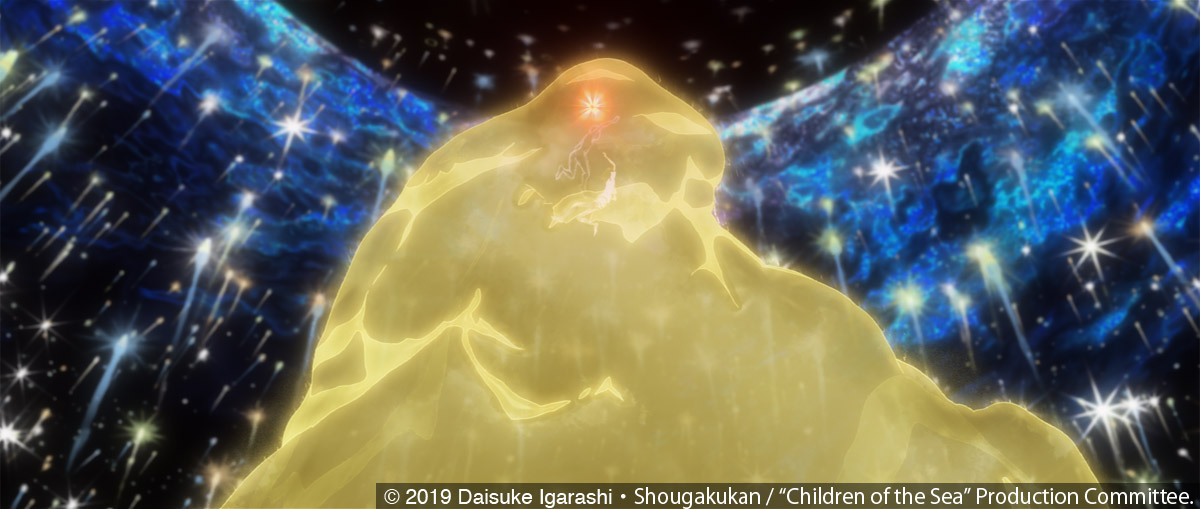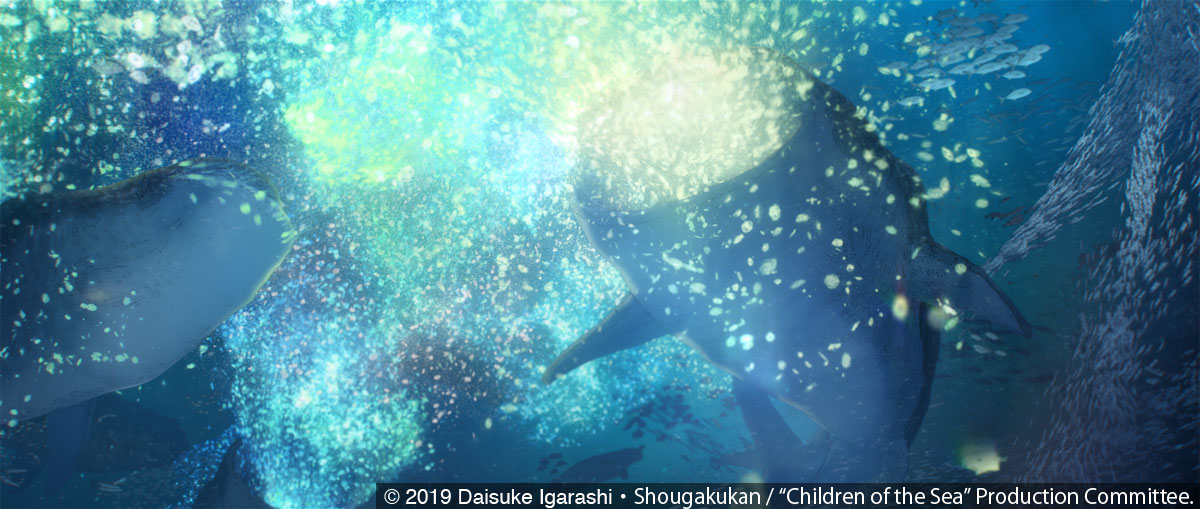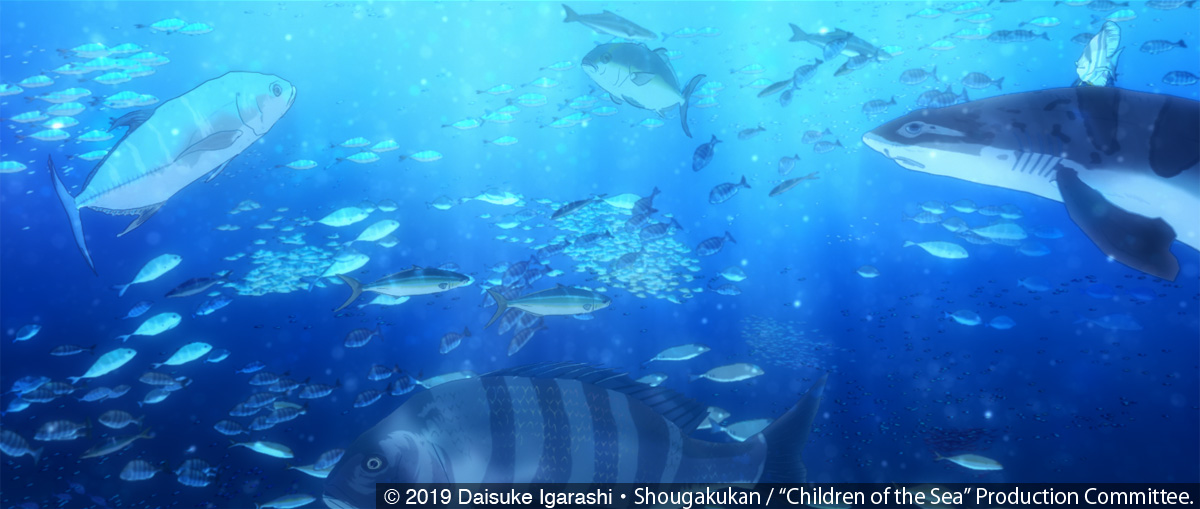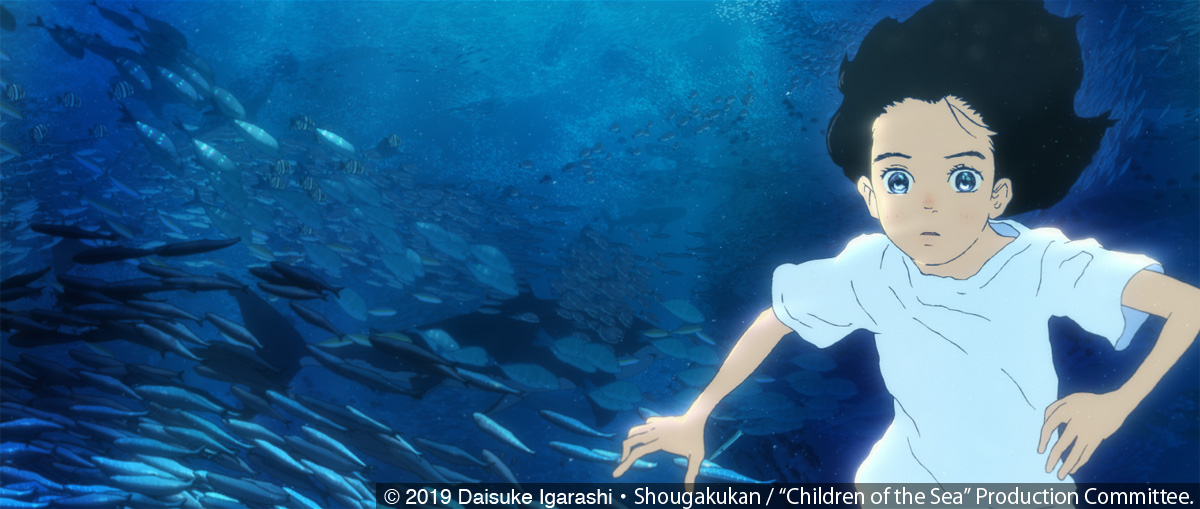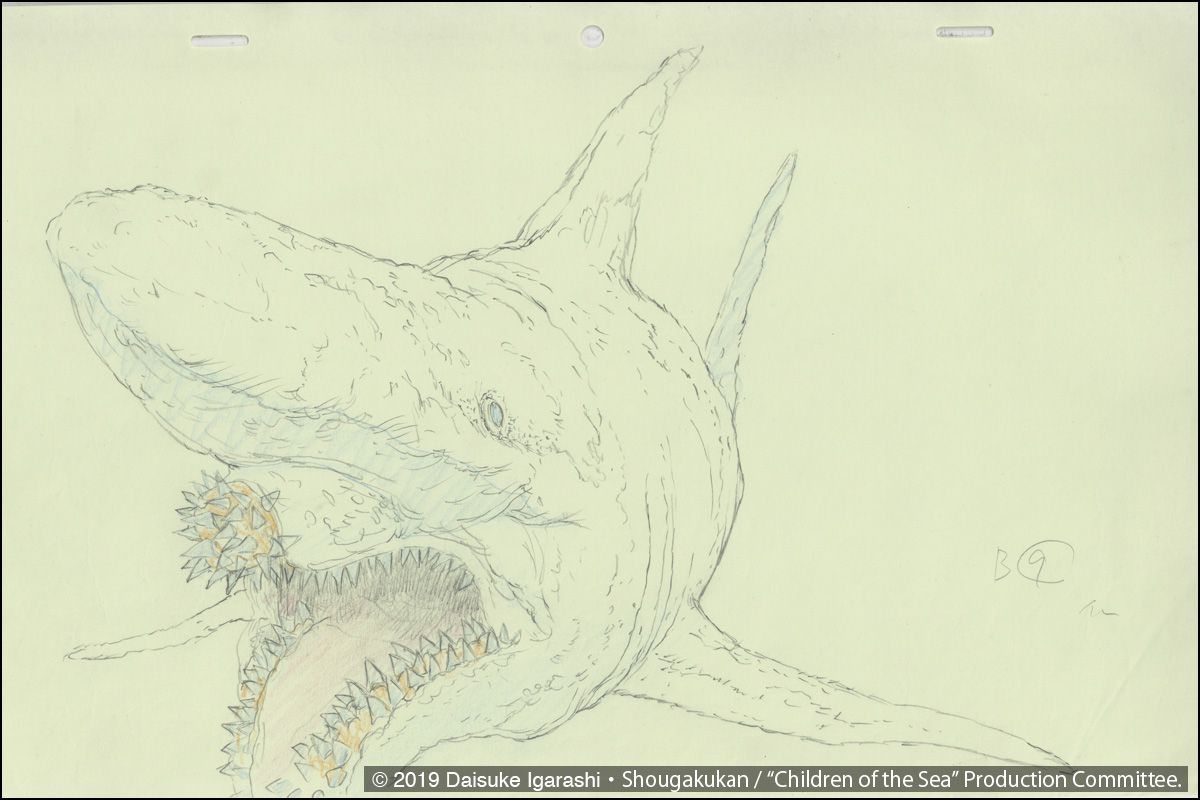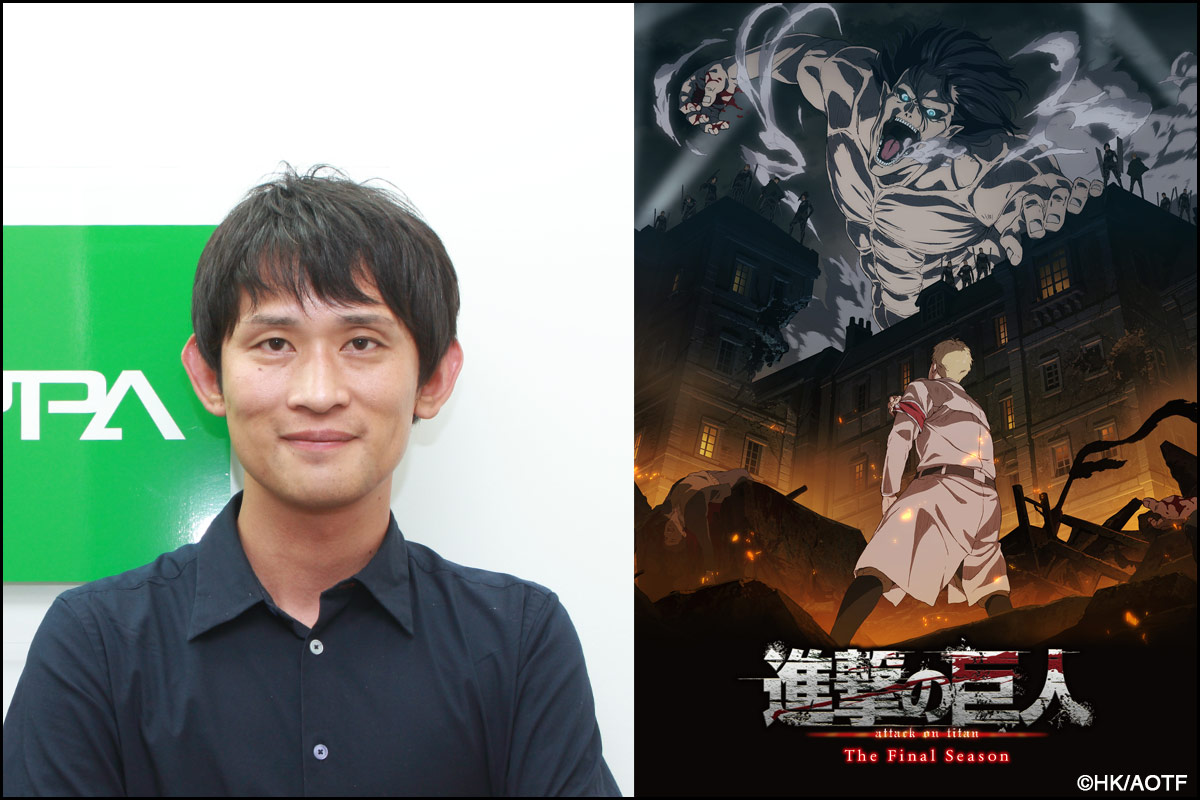“Children of the Sea”
Synopsis
When Ruka was younger, she saw a ghost in the water at the aquarium where her dad works. Now she feels drawn toward the aquarium and the two mysterious boys she meets there, Umi and Sora. They were raised by dugongs and hear the same strange calls from the sea as she does. Ruka’s dad and the other adults who work at the aquarium are only distantly aware of what the children are experiencing as they get caught up in the mystery of the worldwide disappearance of the oceans’ fish.
Film Credits
Based on: Children of the Sea by Daisuke Igarashi
Director: Ayumu Watanabe
Co-director, character designer and supervising animator: Kenichi Konishi
Art Director: Shinji Kimura
CG Director: Kenichiro Akimoto
Music: Joe Hisaishi
Producers: Eiko Tanaka (STUDIO4°C)
Production company: STUDIO4°C
STUDIO4°C is one of the leading animation studios in Japan, having developed animated features that acquired international acclaim, such as Mind Game (2004) and Tekkonkinkreet (2006). After being in production for over five years, their new featured film Children of the Sea (2019) was officially screened during the Annecy International Animated Film Festival 2019. Daisuke Igarashi’s manga of the same name, which has the mysterious theme of the origin of life on Earth, was made into a film with dynamic animation and beautiful, detailed and delicate background art, which are both the representative characteristics of STUDIO4°C’s works. The music was composed by Joe Hisaishi, who is famous for writing music for films by Hayao Miyazaki and Takeshi Kitano for many years. Specifically, the scenes of the main characters with lives in the ocean – the key part of the story – are animated with very dynamic moving imagery.
We had a special opportunity to hear the story behind Children of the Sea from the main creators, including the director Ayumu Watanabe. We are happy to be able to deliver their precious words to you.
(You can also read our special long interview with Ms. Tanaka, the CEO of STUDIO4°C from here).
Special Interview
Interviewees: (from left to right) Jasbeer Kootobally (CGI creator), Ayumu Watanabe (Director), Kenichi Konishi (Co-director, character designer and supervising animator), Miyuki Ito (Color designer), Masataka Aoki (Line producer), Kotaro Hirano (CGI creator)
Hideki Nagaishi (HN): Mr. Watanabe, when you read the original comic, what of it attracted you the most and how did you think to express that in animation?
Ayumu Watanabe: The things from the original Manga that caught my heart are firstly the detailed, expressive illustrations, which were accomplished by Mr. Igarashi’s high drawing skills. As a whole, they are visuals with a strong impact.
I could imagine the depth of its story just by seeing the cover of the manga. Soon after I opened it and started reading, I was pulled into his talent of drawing and storytelling, and then I plunged into the depths of the story’s theme. As a reader, it was like an overwhelming amount of information conveyed as Mr. Igarashi’s illustrations were directly flowing into me.
The second charm of the original manga for me is its simple but magnificent and profound theme on the relationship between life and nature. So, I aimed to tell the story via animation without cutting down on its attractiveness by making “not slimming down on the theme and amount of information from the original manga” as the mission of the film.
HN: Mr. Watanabe, what kind of message or experience do you want to deliver to the audience through the film?
Ayumu Watanabe: My wish is for the audience to experience the things and visuals Ruka – the film’s main character – experiences through the story, together with her. I hope that the audience draws their own conclusion, such as the life force, planet Earth, and the Universe by interpreting freely by themselves. If this film can be a part of the audience, by allowing them to reflect, this film would be able to have the meaning of its existence. The main message of this film is very simple: it is “the mystery and joy of life” and Ruka’s personal story, and each individual audience member are also free to feel that.
HN: This is a question to Mr. Watanabe and Mr. Konishi: I would like to hear the story behind the scenes in the sea such as the scene of “the festival”. For those scenes, what kind of research did you do and how did you stretch the image for the scenes from the drawings in the original comic?
Ayumu Watanabe: How did you transform my storyboard into the final visual of animation, Mr. Konishi?
Kenichi Konishi: First of all, the design of the story’s universe originated in the director’s mind and he incorporated his vision onto the storyboard. Then, I received the impression and developed the visuals of the film based on his storyboards, and in some cases expanding his visions. The role of my position in the team was responsible for managing the final visuals for the animation. Each animator gives me keyframes with suggestions on the final look. Hence, I was like the final point in the pipeline where all the creators’ individual visual visions of the film gathered and merged together to form output the animation with the final visuals.
I’m very interested in Mr. Watanabe’s interpretation of the original Manga to draw each scene of the film on the storyboard, as his storyboard is the original of the all visuals of the film.
Ayumu Watanabe: I recalled the motif of each scene from the original Manga while keeping in mind that I want to let audiences experience what the main character experience in the film at the same time. In particular, I drew the storyboard of “the festival” scene while being conscious of giving the visuals a subjective quality. I thought that it would be effective in animation.
And then, Mr. Kimura, the art director, and Mr. Konishi, the animation director, developed the film’s visuals by reflecting on both the theme I put into the film and images I’ve amplified from the original Manga in my storyboard. All the scenes drawn by them are much more splendid than my storyboard.
It was a sensational outcome for “the festival” scene, in which all the energy of the film is poured into, from not only Mr. Kimura and Mr. Konishi, but from everyone who did their part. The scene ended up becoming the greatest highlight of the film made by all the creative staff.
The production of the film was such an exceptional environment, I think I was probably the first person who could experience the story of the film, not Ruka who is the main character of the film!
HN: Mr. Konishi, what things did you take care in and were particular about when you did the visual design of the characters in the film?
Kenichi Konishi: To make the most of the attractive characteristics of Mr. Igarashi’s original works, I didn’t simply copy the visuals of the original manga. I had a certain amount of time to get my body accustomed to Mr. Igarashi’s illustration style to allow the visuals to permeate my body, and only after that I redesigned the characters’ visuals for the film.
When I design characters for an animation based on an original Manga, I draw their visuals for the animation after familiarizing myself with the original Manga’s visual style and making the illustration style as my own. However, in this film, I could not come up with a visual design of the characters that delivers the attractiveness of Mr. Igarashi’s original visuals to the audience only by my usual character design process alone.
So, while I follow my personal intuition in drawing the foundation of the characters’ design, I relied on the design of the original manga to illustrate the detail of the characters. In other words, the visuals of the characters wouldn’t be in Mr. Igarashi’s taste if I drew the details of them through my vision. Hence, in the process of this film’s production, I selected the visual design of the characters for each cut that conveys Mr. Igarashi’s stylistic tastes to the audience in the best condition.
HN: You said that you’ve made your body get used to the illustrations of the original manga. Is that a matter of repeatedly copying Mr. Igarashi’s illustrations until you are able to draw his visual style at a satisfactory level?
Kenichi Konishi: The role of character design isn’t as simple as just designing characters with proper proportions and accurate anatomy just because the original creator, Mr. Igarashi, is a manga artist with a realistic drawing style.
For example, the original manga characters by Mr. Igarashi have the extremities of the body – the tips of their hands and feet – slightly enlarged. When I draw the characters’ design for animation, I use two different design styles: one is with their hands and feet being smaller and the other is with their hands and feet being drawn bigger, which remains faithful to Mr. Igarashi’s illustrative style. I would be unable to distinguish between the two design styles in the film without allowing Mr. Igarashi’s tastes in visuals infiltrate my body. The process of getting my body used to the original manga’s illustrations requires time for making that possible. So, it’s not a simple matter of repeatedly copying his illustrations.
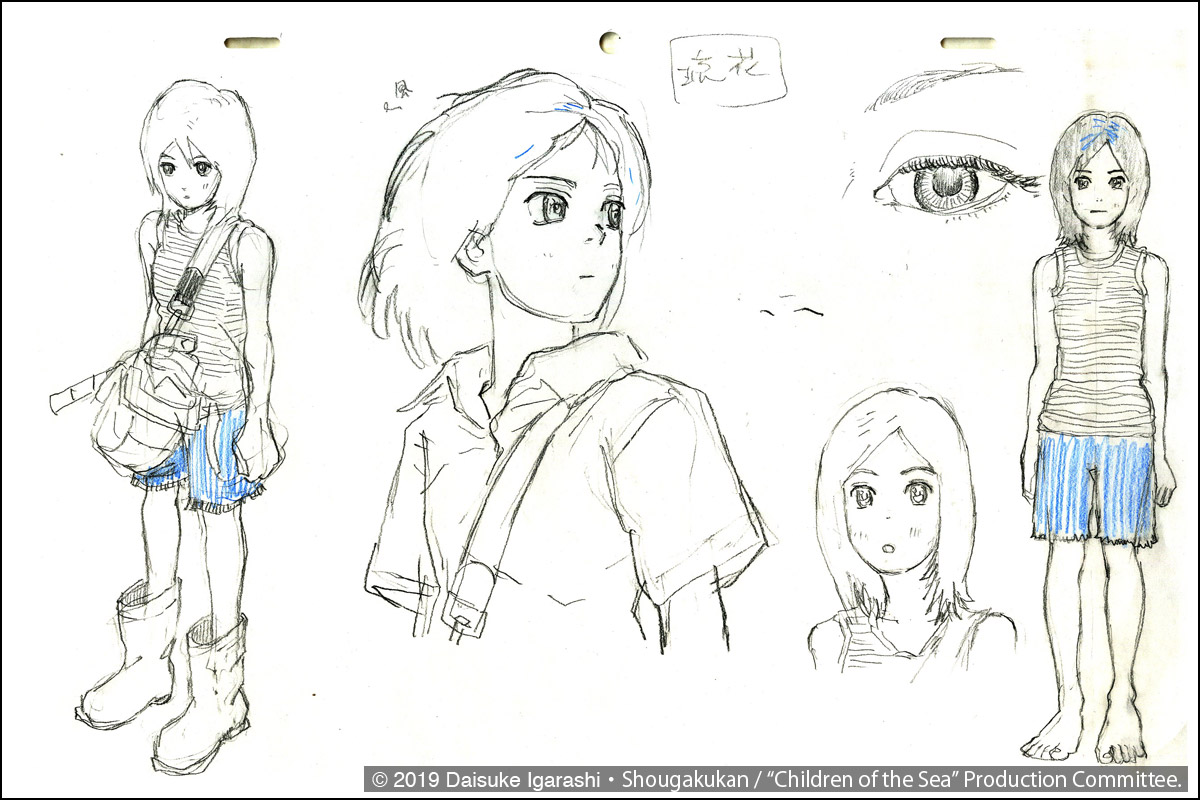

HN: Mr. Konishi, could you please let us know the scenes in the film that you’ve particularly struggled with and the scenes you have a special attachment to as the supervising animator?
Kenichi Konishi: It is the shots that are zoomed in to each character. For me, drawing those shots is not painful, but actually fun. However, it takes more time to make a closeup drawing than for the other shots in the film. Even if a still drawing held in a shot becomes a powerful visual expression, the shot wouldn’t work because animation production is not concerned with a single drawing; it needs to move. It means that creating in-betweens become harder and takes more time with those shots. It became one of the reasons the schedule had to be pushed back.
HN: Ms. Ito, could you describe your job in more details? Your job title is Color designer in this work.
Miyuki Ito: I think this is a unique job role in Japanese animation. In Japan, it is rare to have concept art at the beginning of animation production. With this title, a team that handles color consists of the background art department and myself, a color designer. Shinji Kimura, the art director, worked on background color design and color scripts and I handle the color design of characters, effects and CG models. So, it might be said that my role is being a color coordinator of characters. It’s hard to explain!
HN: What was your first mission for this film project?
Miyuki Ito: The first thing I did for the film was deciding the basic colors of each character after the visual design of all the characters completed.
HN: At that time, did you already have the image boards drawn by the background art department?
Miyuki Ito: Sometime I had, sometimes I didn’t. The process of color design for background art and characters were totally separate. Mr. Kimura was only responsible for the color of background art and I decide all the colors in the film except for background art. For example, to make a color script of a scene, Mr. Kimura decides on the colors of environments with nature and architecture and I manage the colors of all moving things in the scene, such as characters.
That is to say, what I do is manage the coloring of characters to fit in with the background art, which I received from the background art department, by considering the light in the environment, light reflectivity, color brightness and so on. So, the basic process entails having the background art drawn along with the visuals of the universe of each scene and the coloring of them, which are handled by Mr. Kimura, the art director. Then I set up colors of the characters to fit them into the background art properly.
HN: Ms. Ito, could you please let us know what did you take care of and what was difficult for you through the production of this film?
Miyuki Ito: The number of colors I can use for the main characters is few because their outfits are simple overall, like a white T-shirt and a trouser or a skirt. So, basically, their skin colors are the only thing I could have variation on using colors to express them in each scene. I think that is a difficult part of the film for me.
This is the film which goes back and forth between scenes on land and scenes in the sea, so I take care in the difference of how their skins look between the air and in the sea. For example, I made their skin colors a bit bluish by putting a kind of water filter with a light color contrast. On the other hand, in the scenes on the ground, their skin colors are clear and distinguishable. I take care in the colors of their eyes in detail when they are on the ground to make sure the audience can see their eye colors well.
Another difficult thing is the color selection for the abstract scenes, in which animators create the things I haven’t seen in real life and drawn, such as the scenes of “the festival”. I struggled with that a lot.
HN: It is my personal impression, but the color scheme through the scenes on land, in the sea, and of “the festival” managed to remain consistent throughout the film. For instance, even though you use very bright colors in the scenes of “the festival”, these colors do not deviate from the color palette of any other scenes in the film. So, the feeling of immersion in the scenes of the film is not broken at those scenes. In terms of adjusting to the colors of each scene, how did you communicate and work with Mr. Kimura, the art director?
Miyuki Ito: I have long experience working with Mr. Kimura, to the point where we understand each other with what to do without exchanging any words! I’ve always selected the colors by taking care in making the illustrations of characters not float nor sink in the background art.
Ayumu Watanabe: I think, surely, Ms. Ito and Mr. Kimura tries to read each other’s minds. If we imagine we are using playing cards, it makes me wonder if each of them had several possible cards in their minds that they later make known to each other. For example, if they had cards on the answers of the question “If the background art is like this, what colors would the characters be?”, they would select and present one card to each other after saying “Ready, set, go!”
Miyuki Ito: Very much so!
HN: I would like to move on to the production of the scenes in the sea with CGI. Could you please let us know what you did to develop the scenes of dynamic composition and bring life to the sea creatures?
Kotaro Hirano: I was mainly responsible for animating the 3D models of large creatures such as whales and whale sharks, and Jasbeer took charge of the school of fish and the mass of small fishes. It is my personal impression of each other’s role, but we are CGI creators who attract audiences with sheer quantity and who pursue the coolness of a single material.
In terms of the production method of the 3D animation of whales, firstly I animate them as 3D CGI. After that, 2D animators decide the movement of whales at almost all shots with hand line drawings. Finally, I complete each cut by adjusting the 3D models to forcibly trace the line drawings and give them life.
I’m a little nervous to talk about this in front of Mr. Konishi (laughs), but I made the visuals with the goal of ensuring that the textures do not have that CGI look. There is a tendency of CGI models feeling like a plastic doll is moving, so I decided that it’s impossible to create the atmosphere of hand-drawn drawing animation, which gives the illusion of life, only by CGI. Hence, I decided to add more hand drawing elements to the CGI, and the final picture be the result of lots of various, overlapping materials. That is to say, for me, those are the sort of things that are just a jumble of various things, which is hard to categorizes as just 3D CGI or 2D animation (laughs).
As you know, 3D animation production is divided labor and generally each animation title has only one 3D model of each character that is shared among the team members to use in multiple scenes throughout the title. However, the same whale models in this film have different set-up for each cut.
As I customized the set-up of the 3D models of whales to allow them to behave the best in each cut, keeping them aligned with my personal policy of making the 3DCGI the same as hand-drawn 2D animation, I became the only person in the team of the film who could touch the whales’ 3D model! But, I think that is the reason why I could achieve the final visual.
Jasbeer Kootobally: Regarding my cut with all the fish going a bit crazy at the end, we used a particle system for that. We have a lot of fishes with different animation loops, and then create various particle systems to create that deep volume of fish. We also have individually-made animation, so for the fishes that are closer to the camera, we don’t use particles, we used individual animation on the fish, so we have individual, non-particle fishes with animation on it following a curve.
The reason for that is since it’s near the camera, you see more of the fish. With a particle system, you don’t have a lot of control with how they intersect and interact or collide with each other. Sometimes they will get too close to each other and they intersect, so if it is too close to the camera, you can actually see that they are going through each other. So, for the fishes that are far away, we used particles, but not for everything that is close to the camera. There are lots of types of fish in that scene.
HN: To be able to animate that many fish, what kinds of research did you do?
Jasbeer Kootobally: I watch a lot of video references, because there is a lot of them, especially with sardines, the movement of the sardines, and the way they move in groups. So, I spent a lot of time watching videos and YouTube videos that we also have collected. We just watch them noting especially the depth, because the farther way it, is more you cannot see, but you still see the movement of the fish. I also did compositing as well.
So, I watched the videos to see when it is in front of the camera, how we perceive the color and movement, and how the further away it is, the more it gradually mixes together with the color of the sea. So, that is the research I have to do.
Obviously in the sea, the fish move however they want, but for the animation, you have the storyboard and everything that has been provided to you, and then you have the characters moving as well. So, with the framing of the scene, you have the characters, the big fishes and the whales moving, but then you have all the different small fishes going around. So, everything has to work together.
If a lot of things are happening, you still need to able to tell what’s going on and see the characters and the fishes, so I need to get them to the right places, get the right fishes, and getting the right movements, with some going this way and some going that way. They are not always my decision to make, so the way I work is I’m provided with the basic layout, I know the storyboard, and then I start populating the scene with as much fish as I want. Sometimes I know what are the fishes in that scene, so some will be sardines, other will be big fishes, something like that. These are told for me, but how much fish to put is not up to me.
So, I go and put according to how it feels for the scene and looks good, and then I send it to check and if I put a wrong fish or maybe one of the fishes from the particle system are too close, in which case they need to be farther away. These are the checks that I get back and then I correct them. Finally, we end up having the final layout for that scene.
HN: Sounds complicated! The basic information from the storyboard is 2D but all of your work is, of course, in 3D.
Jasbeer Kootobally: Because that’s the thing with 2D. It’s two dimensions, so you see all at once, but with 3D, there is a lot of space between where the camera is and where the farthest fish is, and taking into consideration the camera angle and camera lens. At the same time, let’s say there are five different fishes from the camera to here, we would then separate them on different layers. We rendered out the further one on a different layer and then we do closer and closer to the camera, so that when we do the compositing in the end, we have full control on how much we can see and how to add depth to that.
That’s why at the end we think you can’t tell what is 2D and 3D, but you know its 3D because there’s depth to it.
HN: Lastly, I would like to hear from all of you your impressions of watching the completed film for the first time.
Masataka Aoki: Then it should be my impression of the first print of the film at the preview screening for the staff.
I felt that a quite magnificent thing has been created in form of a film, and at the same time felt immense gratitude to all of the staff.
As animation visuals and sounds are developed separately, I had watched many silent moving images of this film for a long time. So, I attended the audio mastering of the film, but I felt that the depth of the film’s space has expanded by combining moving images and sounds.
This film needed more than five years to complete and it’s been a really long production period compared to normal animated features in the Japanese animation industry. It makes me emotional because I had always been seeing over staff’s works throughout the period as the line producer. Therefore, it is difficult for me to have an objective opinion when I watch the completed film, actually. Anyway, I personally feel that this film could be a great, one-of-a-kind film.
Kotaro Hirano: In my case, when I saw the scene in the latter half of the movie where a whale appears from the sea by opening and closing it’s big mouth, which is one of the scenes I was responsible for, I thought, “I won!” That scene moved me the most, and I thought it was really great.
It was during the production of the film, but the most moving moment for me during the long production period of the film is when I saw first the key frames I received from Sanae Shimada, the animator who took charge of water effects through the film. Those keyframes will probably flash before my eyes when I die!
Kenichi Konishi: I was involved in all the scenes in the film, so I think this project could become such a great film because all the staff did such fantastic work.
In terms of my first impression of the completed film, the ending song (which I never heard until then) fits perfectly as the last piece of the film and it works so well with the film’s direction. It had exceeded my expectations, and I was so moved by that. Everything worked like clockwork!
Even though I made this film by making everyone overwork, I could be the one who left a scar in this film in terms of a completed product. My role as the supervising animator was checking all the shots of the film and then adjusting and revising the shots, in which I can give the OK, until they can reach an acceptable quality for me. However, there are some shots in which I couldn’t bring to that level because I ran out of time.
So, I was annoyed by my own uselessness in that regard, which was how I thought when the film was completed. I feel sorry for all the staff involved about that and I’m often frustrated with myself. Of course, I’m proud of this film because it deserves praise. But, on the other hand, I was sorry for many people including Mr. Igarashi that I could not accomplish my role perfectly even though I had a longer production period than with general animated feature film projects in Japan. Everyone did fantastic work for the film but I think my work was not good. I am ashamed of it.
Masataka Aoki: No, I don’t think so. That was because Mr. Konish put a lot of effort into all the shots in the film. I think, thanks to that, we could increase the number of high quality and detailed cuts throughout the film.
Kenichi Konishi: Well, there are indeed many elements in a feature film development, so I also think, in terms of raising the quality of the film, I could not manage well the negotiation between the studio and myself on its production period, or manage reading each other’s ‘playing cards’.
Anyway, as for the mission of raising the visual quality, I feel like I could’ve done better than that.
Miyuki Ito: Actually, I had a similar feeling with Mr. Konishi. I worked on all the shots in the film except the shots which are just background art only and no characters. At some point during the production, I became very busy and hectic to deal with all the shots I received one after another. I did my best but there were a few shots I didn’t get an OK from Mr. Watanabe and Mr. Konishi when the film completed. So, I was a bit nervous thinking “what did they think of those shots?” when I watched the first print of the film with the other staff.
In terms of my impression of the first print of the film, the silent moving visuals we made are united with mysterious music and sounds and the pure elements of the characters expressed by the voice actors and actresses, so there are not only visual expressions of the story but also sound expressions of the story. It gave the film great depth and made the film’s spatial representation wider more. So, I was emotional by experiencing how that feeling of completion felt from the animation project.
Jasbeer Kootobally: I was just happy, I was really happy to see that everyone’s hard work, because we’ve worked so hard and so long on it, actually paid off because what I saw was really amazing. I was just very happy that all that work was put into making something so beautiful.
Ayumu Watanabe: Actually, the most happy and fun moment for me is the time during production when I’m thinking various things like “let’s do this kind of expression this time” or “we might arrange this like that”, and making new findings every time I receive rushes (raw and unedited shots) from each section.
Hence, when I watched the first print of the film with the staff, I thought that the journey of this film project has concluded. It is a mysterious film that made me want to continue its development forever, if it could allow me so. Thus, the first print of the film didn’t mean that it was the completed product for me and I still thought that there might be something I could change.
I think, presumably, all the other staff there with me also had a similar feeling because everyone fell in love with developing the film. Among them in particular, Mr. Konishi tried to continue drawing to the end, brushing up the visual of the film even more.
Regarding my impression of the first print of the film, I’m actually still thinking about how I personally consider and evaluate this film for understanding. As I talked a bit in the beginning of this interview, I would like to leave this film to the audiences and hope that they would individually weave each of their own story.
Kenichi Konishi: Mr. Takahata showed a similar reaction when his film The Tale of Princess Kaguya (2013), which I took part in the production, was concluded. He said to me, “Oh, is this really the end?”, when the final rush got the OK. I think that he really meant “I still want to continue working for this film” behind his actual words.
As a film production period becomes longer, it becomes harder for the staff to work. On the other hand, the staff tends to start having fun putting the effort together in completing a film when they are in the homestretch, particularly if a film project has a very long production period. Even though it was hard, I didn’t want that time to end! So, I worked on two feature films in a row which I experienced the same type of last-term production!
Ayumu Watanabe: Yes, it was kinda like that!
In terms of scheduling and producing, I think this film ended up being a very tough title.
Miyuki Ito: Actually, this film project was referred to as the Sagrada Família in the Japanese animation industry!
HN: I think that in general Japanese animation studios develop a featured-length film in a shorter production period than studios in Europe. I personally feel that Japanese animated features could have some edgy artistic expressions because in the restricted production period, creators work very hard while pushing themselves to their limit.
Ayumu Watanabe: I agree. I think animation production period in Japan is like a shooting star. Its characteristics are its brevity and brightness at the very last moment and being completed quickly, like sparkling. I think that the attractiveness of Japanese animation might be supported by that instantaneous force.
Kenichi Konishi: The time flows differently throughout a whole animated feature film production period. More than half a year of time is condensed into the last three months.
Ayumu Watanabe: The last three months is the moment a shooting star enters into the atmosphere of the earth. The fragment of a shooting star, which has traveled and revolved around the galaxy, sparkles instantly and vanishes. It’s very fleeting.


